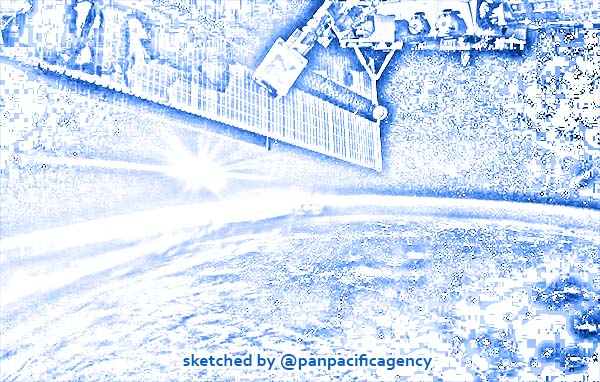Mars helicopter kicks up ‘cool’ dust clouds — and unexpected science

A handout picture made available by NASA and taken by US astronaut Scott Kelly from the International Space Station (ISS) on 07 October 2015 shows an aurora looming over Planet Earth. The Aurora Borealis, or Nothern Lights, have been visible this week. EPA/SCOTT KELLY / NASA. Sketched by the Pan Pacific Agency.
BOULDER, Jun 16, 2021, Nature. Ingenuity, NASA’s pint-sized Mars helicopter, has kicked up some surprising science on its flights over the red planet. When whizzing through the Martian air, its blades sometimes stir up a dust cloud that envelops and travels along with the tiny chopper, Nature reported.
In several videos of Ingenuity’s flights, planetary scientists have seen dust whirling beneath the helicopter’s rotors — even when Ingenuity is flying as high as 5 metres above the Martian surface. That suggests that dust can get lifted and transported in the thin Martian air more easily than researchers had suspected.
“It’s really cool,” says Mark Lemmon, a planetary scientist at the Space Science Institute in Boulder, Colorado.
Mars is a dusty planet, so it’s not surprising that the helicopter kicks up dust during takeoff and landing, much as helicopters on Earth do when operating in the desert. Engineers designed Ingenuity to operate with a lot of dust blowing around as it takes off and lands. But scientists are surprised by how the dust interacts with the drone during flight. By watching how Ingenuity entrains dust as it flies, researchers can better understand the dynamics of Mars’s thin atmosphere, where tornado-like ‘dust devils’ often form when the Sun heats the air and afternoon winds begin to blow.
“There’s an unanticipated atmospheric science experiment coming out of this,” says Jim Bell, a planetary scientist at Arizona State University in Tempe.
Ingenuity is what NASA calls a technology demonstration, whose only goal is to show that flight on Mars is possible. So “anything we can learn from it scientifically is icing on the cake”, says Brian Jackson, a physicist at Boise State University in Idaho who studies Martian dust.
Bizarre dust clouds
Space scientists and amateur image processors have been analysing images and videos of the helicopter that NASA has posted online.
The agency’s Perseverance rover carried Ingenuity to the surface of Mars in February. Its job is to roll around Jezero Crater and explore the rocks that were once part of an ancient lake, to look for signs of past life. In April, Ingenuity became the first machine to achieve powered flight on another planet. It has made seven flights so far.
On the first two flights, Ingenuity kicked up a fair amount of dust as it rose 3 to 5 metres above the surface, but it didn’t travel far from its takeoff point and the dust cloud phenomenon wasn’t pronounced. On its third flight, the helicopter rose 5 metres and then flew north from its takeoff point, kicking up a cloud from several light-coloured patches it flew over on the Martian surface. Those patches might be small hollows where dust has collected in the Martian landscape, says Lemmon. “A lot more dust comes up at that moment” when the helicopter flies over them, he says.
Ingenuity’s blades spin at more than 2,400 revolutions per minute — a dizzying rate necessary for the helicopter to achieve lift in the Martian atmosphere, which is just 1% the density of Earth’s.
It was Ingenuity’s fourth flight, on 30 April, that really intrigued scientists. A video, recorded by Perseverance from a vantage point nearby, shows the helicopter rise, disappear from view, and then re-appear while enveloped in an enormous cloud of dust following a 133-metre flight.
The video confirms that Ingenuity was flying along with the 3.5-metre-per-second wind, says Håvard Grip, the helicopter’s chief pilot at the Jet Propulsion Laboratory in Pasadena, California. “The dust was getting carried beneath us,” he says.
Lemmon plans to compare tracks on the Martian surface left behind by natural dust devils with those where the helicopter kicked up the most dust. That will help researchers to better understand how winds blowing across Mars can lift dust and spin it into dust devils. The Martian atmosphere is so thin that scientists have had a hard time explaining how so much dust gets aloft, says Jackson. “We have to know how that first step in the process works,” he says.
Ingenuity ran into some trouble on its sixth flight, on 22 May; it began wobbling because of a glitch in its navigation system, but managed to land safely. On its seventh flight, on 8 June, it flew 106 metres with no problem.
The helicopter has been wildly successful in demonstrating flight on other worlds, says Grip. In the future, bigger helicopters could travel long distances and scout out areas where wheeled vehicles cannot travel. “It’s just so clear that this is definitely a way that could be used to explore Mars,” he says.
Ingenuity will now tag along as Perseverance begins to roll south from its landing site. The helicopter will probably make additional flights every two weeks or so from now until the end of August, when operations are expected to draw to a close.
Perseverance has been exploring the rocks that make up Jezero Crater’s ancient lake bed. Team scientists are in the process of deciding where to drill to collect their first geological sample — either from the fractured rock that makes up the crater floor, or from a dune-laden region nearby. It will be the first in a collection of rock cores that are destined for pickup by future spacecraft, which will fly the material back to Earth — in the first-ever sample return from Mars.